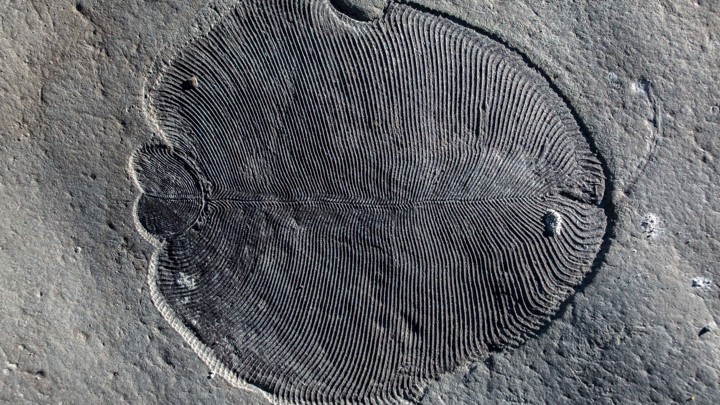A recent paper in Science authored Ilya Bobrovskiy, Janet Hope and colleagues from ANU, the Russian Academy and European institutions has remarkably (and convincingly) discovered molecules of fat in Dickinsonia, a marine genus of the Ediacaran biota.

This has confirmed that the 558 million year old Dickinsonia is the earliest animal in the geological record and maybe a presursor to – you!

The strange creature called Dickinsonia, which grew up to 1.4 metres in length and was oval shaped with rib-like segments running along its body, was part of the Ediacara Biota that lived on Earth 20 million years prior to the ‘Cambrian explosion’ of modern animal life. The Ediacara biota are a diverse assemblage of macroscopic body forms that appear in the sedimentary rock record between 570 million and 541 million years ago. First recognized in Namibia and Australia, these remarkable organisms have since been found in Russia, China, Canada, Great Britain, and other regions. Although they immediately preceded the rapid appearance and diversification of animals in the Cambrian (541 million to 485 million years ago), their position within the tree of life has long been a puzzle. Some Ediacaran fossils appear segmented, but most lack obvious characters such as appendages, a mouth, or a gut that might link them to animal clades.

Prior to this study Dikinsonia affinities were unknown and while its mode of growth is consistent with a bilaterian affinity some thought that it belong to to the fungi, or even an “extinct kingdom”

Bobrovskiy et al. conducted an analysis using lipid biomarkers obtained from Dickinsonia fossils and found that the fossils contained almost exclusively cholesteroids, a marker found only in animals. Thus, Dickinsoniawere basal animals. This supports the idea that the Ediacaran biota may have been a precursor to the explosion of animal forms later observed in the Cambrian, about 500 million years ago.
Obtaining evidence of cholesteroids first involved finding exceptionally well preserved fossils. The Dikinsonia fossils used in this study came from a narrow strata in the remote White Sea are of Russia.
Lead senior researcher Associate Professor Jochen Brocks said the ‘Cambrian explosion’ was when complex animals and other macroscopic organisms—such as molluscs, worms, arthropods and sponges—began to dominate the fossil record.
“The fossil fat molecules that we’ve found prove that animals were large and abundant 558 million years ago, millions of years earlier than previously thought,” said Associate Professor Jochen Brocks from the ANU Research School of Earth Sciences.
“Scientists have been fighting for more than 75 years over what Dickinsonia and other bizarre fossils of the Edicaran Biota were: giant single-celled amoeba, lichen, failed experiments of evolution or the earliest animals on Earth. The fossil fat now confirms Dickinsonia as the oldest known animal fossil, solving a decades-old mystery that has been the Holy Grail of palaeontology.”
Abstract
The enigmatic Ediacara biota (571 million to 541 million years ago) represents the first macroscopic complex organisms in the geological record and may hold the key to our understanding of the origin of animals. Ediacaran macrofossils are as “strange as life on another planet” and have evaded taxonomic classification, with interpretations ranging from marine animals or giant single-celled protists to terrestrial lichens. Here, we show that lipid biomarkers extracted from organically preserved Ediacaran macrofossils unambiguously clarify their phylogeny. Dickinsonia and its relatives solely produced cholesteroids, a hallmark of animals. Our results make these iconic members of the Ediacara biota the oldest confirmed macroscopic animals in the rock record, indicating that the appearance of the Ediacara biota was indeed a prelude to the Cambrian explosion of animal life.